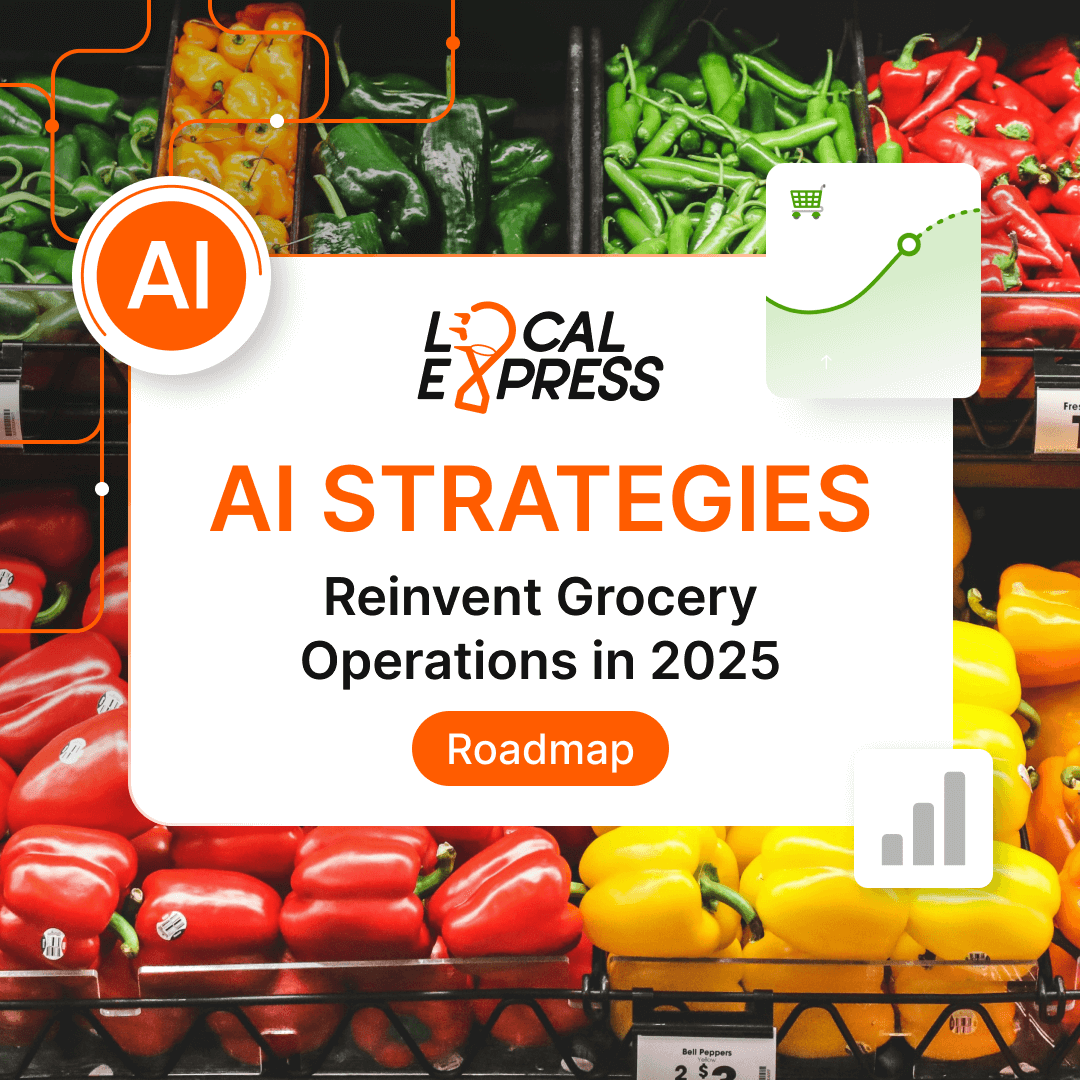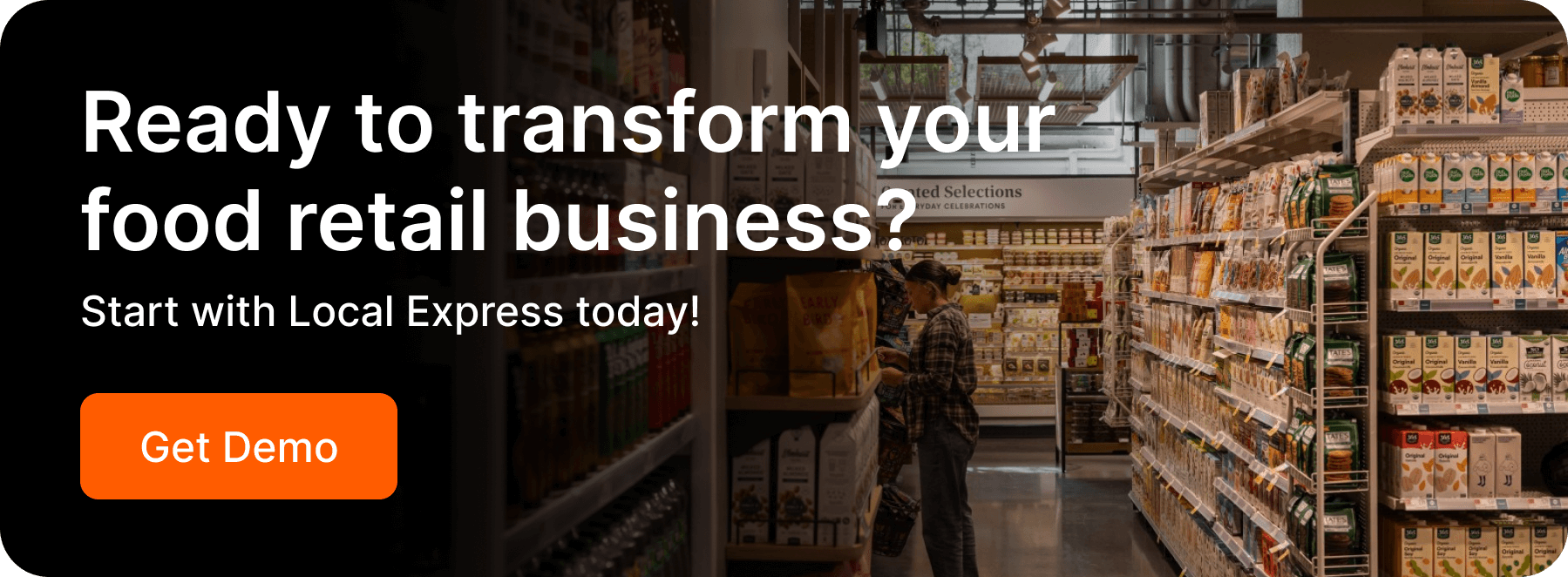


Independent grocers face mounting pressure from national chains that have already deployed AI across inventory, fulfillment, and customer experience. The good news: AI-powered unified platforms now give independent and regional food retailers enterprise-grade capabilities without needing a 20-person IT team. This roadmap shows you exactly how to implement AI strategies that cut costs, accelerate fulfillment, and compete online while maintaining your brand identity.
AI has moved beyond basic automation to become the strategic layer that determines which grocers thrive in 2025. The grocery AI market is experiencing rapid growth, reflecting how quickly the industry recognizes AI as non-negotiable for competitive parity.
Traditional grocery operations rely on disconnected systems where inventory, POS, online orders, and delivery operate in separate silos. AI-native platforms eliminate these gaps by synchronizing every touchpoint in real time. When a customer orders online, AI instantly updates inventory across all channels, triggers picking workflows optimized by store layout, and routes the order to the fastest fulfillment method—all without manual intervention.
The grocery industry is entering an era where AI isn't just about operational efficiency—it's becoming fundamental to understanding and serving increasingly value-conscious and health-focused consumers in real-time.
Large chains already benefit from proprietary AI systems built over years with massive budgets. The transformation happening in 2025 is that unified commerce platforms bring these same capabilities to independent grocers through subscription models. LocalExpress delivers this through an AI-powered unified platform that connects physical stores with digital channels from a single dashboard, with implementation typically taking only a few weeks.
AI-driven inventory management uses predictive analytics to forecast demand patterns based on historical sales, seasonal trends, weather conditions, and local events. This capability prevents the two most costly inventory problems: stockouts that lose sales and overstocking that creates waste.
Retailers using AI for inventory optimization have reported double-digit improvements in inventory turnover. The system analyzes thousands of data points per SKU—historical sales velocity, day-of-week patterns, promotional lift, and even weather forecasts—to predict when specific products will run low and automatically adjust ordering parameters.
For perishable categories where waste directly impacts profitability, AI-driven demand forecasting can deliver double-digit reductions in stockouts and waste.
The most frustrating customer experience in grocery ecommerce happens when someone orders online only to find the item is actually out of stock. Real-time POS integration solves this by updating inventory counts the moment an item is scanned at checkout, picked for an online order, or adjusted during receiving.
LocalExpress's inventory management platform offers real-time inventory tracking, predictive stock analysis, low stock alerts, and seamless POS sync with barcode and Zebra device support. The system prevents overselling and stock discrepancies across all channels while providing mobile and iPad apps for on-the-floor inventory management.
Manual picking workflows waste time as staff wander through stores collecting orders with inefficient routes. AI-powered store mapping changes this completely by organizing collection workflows based on aisle location, department zones, or product temperature requirements.
LocalExpress's order fulfillment system can accelerate order processing by up to 50% based on internal benchmarks through AI-powered store mapping. The platform learns your exact store layout and groups items by aisle, department, or custom zones, enabling pickers to fulfill multiple orders simultaneously without backtracking.
For a typical 40-item grocery order, traditional picking might take 35-45 minutes. With AI-optimized zone-based workflows, that same order takes 18-22 minutes—and pickers can batch similar orders to increase throughput even further.
When items are out of stock, AI analyzes attributes like brand, size, price point, and customer purchase history to suggest appropriate substitutions. Rather than guessing or skipping items, staff receive real-time recommendations that maintain customer satisfaction while preserving basket value.
The system handles flexible fulfillment across:
Most grocery POS systems contain incomplete, inconsistent product data—missing images, abbreviated descriptions, duplicate entries for the same SKU, and no nutritional information. This raw data can't power a competitive ecommerce experience.
AI data fusion integrates and harmonizes information from multiple sources—POS systems, ERP platforms, supplier catalogs, and industry databases—to create a single, accurate master catalog. The AI automatically deduplicates entries, maps field variations, enriches missing attributes, and maintains continuous synchronization as data changes.
This process typically takes weeks or months when done manually. LocalExpress's AI grocery data fusion module automates it, seamlessly integrating data from POS and ERP systems while utilizing advanced AI to enhance product data with images, descriptions, nutritional information, and allergen details.
For retailers expanding to multiple locations or launching on marketplaces, data quality determines speed to market. The AI handles weighted items, variable SKUs (like cut meats sold by the pound), and multi-pack variations that traditionally require extensive manual configuration.
Early adopters report that AI implementation has reduced inventory in challenging categories while increasing product availability—a dual benefit possible only when data accurately reflects what's actually in stock.
Omnichannel means more than having a website and an app—it requires every customer touchpoint to function as a unified system where inventory, pricing, promotions, and loyalty status stay synchronized in real time.
Rather than managing separate systems for your website, mobile app, and kiosk, LocalExpress's omnichannel platform synchronizes in-store and online inventory from a centralized dashboard. A single drag-and-drop interface controls your web storefront, mobile app, and kiosk displays.
This architecture prevents common friction points:
Most large grocery chains have implemented at least one AI solution in their operations, while adoption among mid-sized retailers is still emerging. The gap often comes down to unified inventory visibility—larger chains invested early in systems that sync every transaction across locations.
The unified platform approach enables independent grocers to match this capability without building custom integrations. When inventory management, order processing, and customer data flow through a single AI-powered system, the result is a seamless shopping experience that drives higher customer satisfaction and increased retention.

Labor costs remain one of the largest operational expenses in grocery retail. Self-service technologies reduce staffing needs at checkout while often increasing basket size through strategic upsell prompts.
LocalExpress's scan and pay solution lets shoppers use their mobile phone to scan products while shopping, bag as they go, and complete payment without waiting in checkout lines. The app supports Apple Pay, Google Pay, credit cards, and EBT where permitted under SNAP program rules, making it accessible to all customer segments.
For loss prevention, the platform includes a staff app that validates orders through quick scans, balancing convenience with security.
Self-ordering kiosks create three distinct advantages:
The kiosks integrate seamlessly with most POS systems and provide fully customizable branded interfaces. Implementation includes comprehensive support for setup, training, and ongoing maintenance to ensure smooth operations.
Last-mile delivery represents the most expensive component of grocery ecommerce, with last-mile logistics accounting for up to 53% of total delivery costs. AI-powered routing and unified network management change the economics completely.
LocalExpress's last-mile delivery platform cuts delivery costs by up to 30% through AI-powered routing that optimizes driver routes based on real-time traffic, order density, and delivery time windows. The system instantly connects to DoorDash, Uber, Nash, and dozens of delivery networks through a single integration.
This unified approach means retailers can:
The routing algorithms analyze factors human dispatchers can't process quickly enough:
The platform handles on-demand, scheduled, and bulk orders with zone-based routing that scales delivery capacity during peak periods. Retailers adopting AI report meaningful improvements in labor efficiency through optimized scheduling and task management—benefits that extend to delivery operations.
Selling through Instacart, DoorDash, and other marketplaces expands customer reach significantly—but manually maintaining inventory sync across platforms creates operational nightmares when catalogs drift out of sync.
LocalExpress's marketplace syndication platform deploys catalogs across multiple marketplaces at enterprise scale with AI that automatically maps grocery variations. The system handles the complexity of weighted items, variable SKUs (like deli meats sold by the pound), and multi-pack variations that differ across platforms.
Upload your catalog once through POS integration with NCR, Toshiba, IT Retail, or other major systems, and the AI handles the rest—product mapping, inventory synchronization, and continuous updates.
For chains operating across multiple locations, the platform manages location-specific inventory availability and pricing while maintaining centralized catalog control. Each store's real-time inventory feeds directly to marketplace listings, preventing the overselling that damages ratings and customer trust.
Dedicated implementation managers guide retailers through onboarding typically in 5-14 days depending on catalog size, integrations, and marketplace approvals, dramatically faster than traditional marketplace integration projects that can take months.
Customer acquisition costs for grocery ecommerce remain high, making retention and basket size optimization critical for profitability. AI-powered personalization addresses both while creating a new revenue stream through retail media.
LocalExpress's retail media platform delivers personalized advertising via in-app mobile ads, kiosk retail media, and personalized pricing promotions. CPG brands pay to promote their products in your stores, creating a revenue stream that offsets platform costs.
The AI analyzes customer purchase history, browsing behavior, and basket composition to serve relevant product recommendations and sponsored placements that feel helpful rather than intrusive. Stores using AI for promotional planning report higher promotion effectiveness compared to traditional methods.
Retail media represents one of the fastest-growing revenue opportunities in grocery. Rather than relying solely on product margins, retailers earn advertising fees when CPG brands want to reach shoppers at the moment of purchase decision.
The platform tracks campaign performance with analytics that prove ROI to brand partners, making it easy to build ongoing partnerships that generate predictable revenue.
Prepared food departments, bakeries, and butcher shops face unique operational challenges that generic ecommerce platforms don't address—custom orders, variable weights, prep timing, and department-specific workflows.
LocalExpress's prepared food platform elevates made-to-order operations with customizable menus, order management systems, and kitchen display integration. The AI routes orders to appropriate prep stations, tracks prep timing to ensure food is ready at the promised time, and handles department splitting when orders contain items from multiple areas.
For bakery operations, custom cake orders become straightforward with templates for common customizations, real-time order tracking, and kitchen display systems that show prep priorities. The platform integrates with inventory management to trigger alerts when ingredients run low.
Butcher shop ecommerce requires handling products sold by weight with accurate pricing that updates based on final cut size. The platform supports variable weight items with POS integration that adjusts the final charge when the actual weight differs from the estimated order weight.
The system includes:
All specialty solutions include 24/7 technical support to ensure operations run smoothly during peak order times.

The grocery industry is experiencing several convergent trends that make 2025 a tipping point for AI adoption among independent and regional retailers.
Online grocery sales have grown to account for 12-15% of U.S. grocery sales in 2024. This shift accelerated during the pandemic and has stabilized at levels significantly higher than pre-2020 baselines.
For independent grocers, this creates both challenge and opportunity. National chains invested early in ecommerce infrastructure, but unified platforms now make those same capabilities accessible to smaller operators at a fraction of historical implementation costs.
Industry analysts predict that AI will shift from core operational support to strategic enabler in grocery, where it drives decisions across the entire business rather than just automating existing processes.
This transition favors independents who adopt unified AI platforms. Rather than building separate systems for inventory, fulfillment, delivery, and personalization, platforms like LocalExpress bring it all together in a single implementation.
Retailers adopting AI report meaningful cost reductions within the first 18-24 months of implementation, making the investment economically compelling even for smaller operators.
The gap between recognizing AI's value and actually implementing it often comes down to perceived complexity. The reality: modern unified platforms deploy in weeks with minimal disruption when you follow a phased approach.
LocalExpress's typical implementation takes only a few weeks, guided by experts who ensure smooth transitions with minimal operational disruption:
Weeks 5-6: Launch and Optimization
LocalExpress brings every element together—AI-powered inventory, order management, delivery logistics, marketplace syndication, and retail media—in a unified platform that empowers independent grocers to compete effectively in the digital marketplace without sacrificing their brand identity.
AI analyzes historical sales data, seasonal patterns, weather forecasts, and local events to predict demand with high accuracy. This prevents overstocking that leads to waste (especially in perishables) and understocking that causes lost sales. Retailers using AI for inventory optimization have reported double-digit improvements in inventory turnover, while AI-driven demand forecasting can deliver double-digit reductions in stockouts and waste. Real-time POS synchronization prevents discrepancies across channels that create hidden losses.
Most retailers see measurable improvements within 4-8 weeks of implementation as AI-optimized picking routes and zone-based workflows increase throughput. Full ROI typically materializes within 6-12 months through labor efficiency gains (picking up to 50% faster based on internal benchmarks), reduced errors that require customer service intervention, and higher order capacity without proportional staffing increases. Retailers adopting AI report meaningful cost reductions within the first 18-24 months.
Yes—unified platforms have made AI accessible through subscription models that eliminate the massive upfront development costs large chains historically required. LocalExpress's platform approach means you don't need a dedicated IT team to implement or maintain AI capabilities. Implementation typically takes only a few weeks with expert guidance, and the subscription model includes unlimited technical support. Many independent retailers find the monthly platform cost is quickly offset by reduced waste, improved labor efficiency, and new revenue from online channels and retail media.
Manual product data management creates inconsistencies, missing information, and duplicate entries that delay marketplace launches and cause customer frustration. AI data fusion integrates information from POS, ERP, supplier catalogs, and industry databases to create a single accurate master catalog. The system automatically deduplicates entries, maps field variations, and enriches missing attributes like images, descriptions, and nutritional data. This reduces onboarding time from months to days and maintains real-time synchronization so inventory and pricing stay accurate across all platforms.
AI delivery platforms connect to POS systems through API integrations that synchronize order data, inventory levels, and customer information in real time. LocalExpress integrates with major POS providers including NCR, Toshiba, IT Retail, and others, pulling order details automatically when customers place online purchases. The AI routing engine then optimizes driver assignments based on location, current routes, and delivery time windows. The system supports in-house fleets, third-party couriers like DoorDash and Uber, or hybrid setups—all managed from one platform with white-labeled customer experience that maintains your brand identity throughout delivery.

